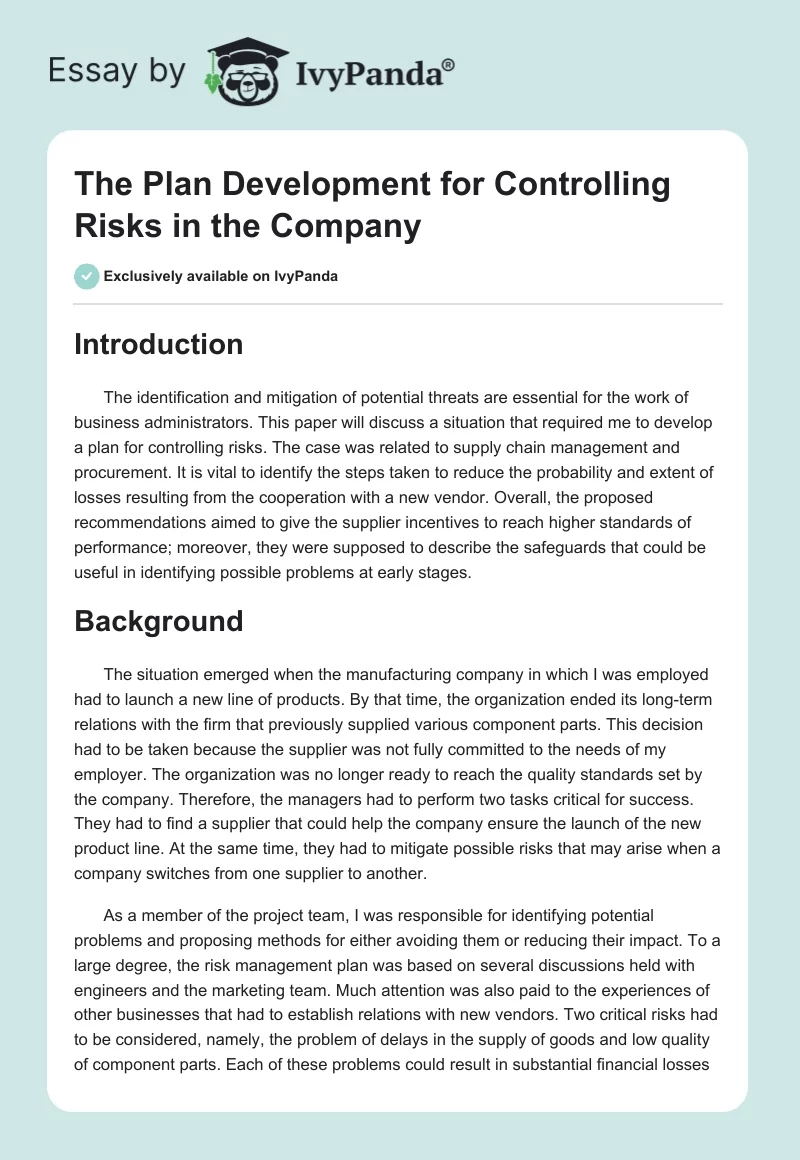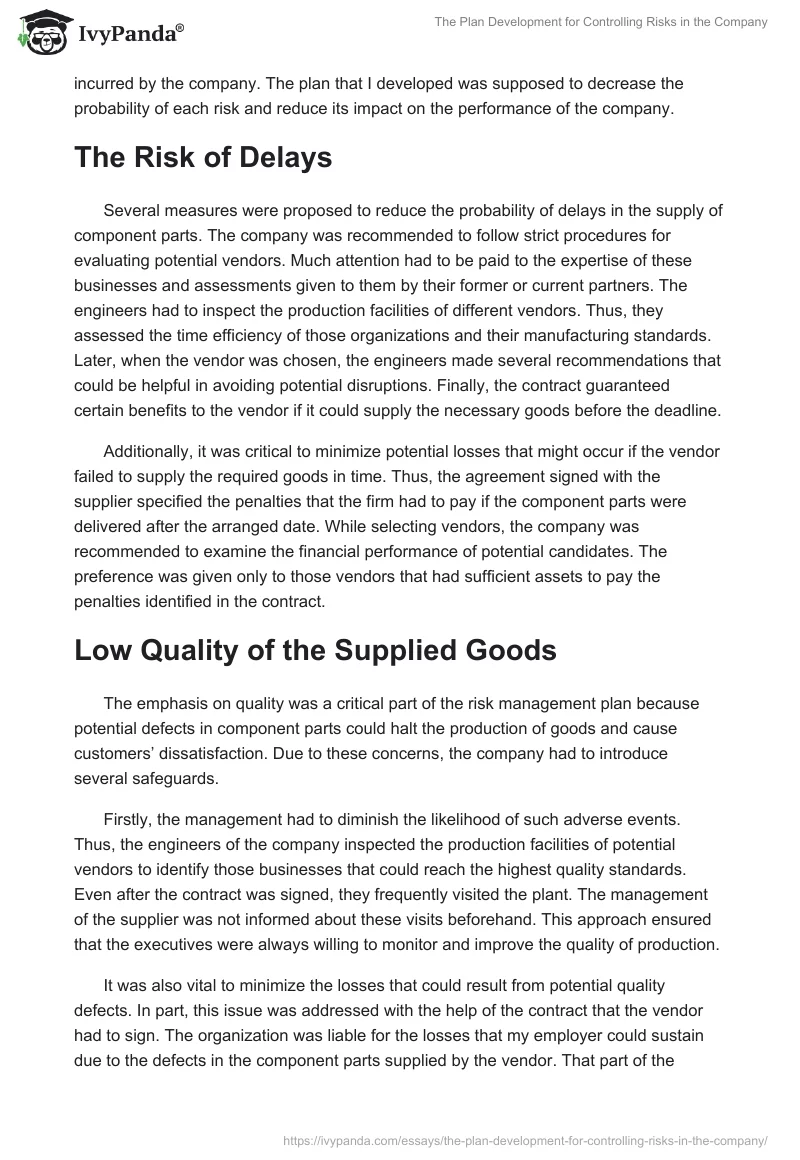Introduction
The identification and mitigation of potential threats are essential for the work of business administrators. This paper will discuss a situation that required me to develop a plan for controlling risks. The case was related to supply chain management and procurement. It is vital to identify the steps taken to reduce the probability and extent of losses resulting from the cooperation with a new vendor. Overall, the proposed recommendations aimed to give the supplier incentives to reach higher standards of performance; moreover, they were supposed to describe the safeguards that could be useful in identifying possible problems at early stages.
Background
The situation emerged when the manufacturing company in which I was employed had to launch a new line of products. By that time, the organization ended its long-term relations with the firm that previously supplied various component parts. This decision had to be taken because the supplier was not fully committed to the needs of my employer. The organization was no longer ready to reach the quality standards set by the company. Therefore, the managers had to perform two tasks critical for success. They had to find a supplier that could help the company ensure the launch of the new product line. At the same time, they had to mitigate possible risks that may arise when a company switches from one supplier to another.
As a member of the project team, I was responsible for identifying potential problems and proposing methods for either avoiding them or reducing their impact. To a large degree, the risk management plan was based on several discussions held with engineers and the marketing team. Much attention was also paid to the experiences of other businesses that had to establish relations with new vendors. Two critical risks had to be considered, namely, the problem of delays in the supply of goods and low quality of component parts. Each of these problems could result in substantial financial losses incurred by the company. The plan that I developed was supposed to decrease the probability of each risk and reduce its impact on the performance of the company.
The Risk of Delays
Several measures were proposed to reduce the probability of delays in the supply of component parts. The company was recommended to follow strict procedures for evaluating potential vendors. Much attention had to be paid to the expertise of these businesses and assessments given to them by their former or current partners. The engineers had to inspect the production facilities of different vendors. Thus, they assessed the time efficiency of those organizations and their manufacturing standards. Later, when the vendor was chosen, the engineers made several recommendations that could be helpful in avoiding potential disruptions. Finally, the contract guaranteed certain benefits to the vendor if it could supply the necessary goods before the deadline.
Additionally, it was critical to minimize potential losses that might occur if the vendor failed to supply the required goods in time. Thus, the agreement signed with the supplier specified the penalties that the firm had to pay if the component parts were delivered after the arranged date. While selecting vendors, the company was recommended to examine the financial performance of potential candidates. The preference was given only to those vendors that had sufficient assets to pay the penalties identified in the contract.
Low Quality of the Supplied Goods
The emphasis on quality was a critical part of the risk management plan because potential defects in component parts could halt the production of goods and cause customers’ dissatisfaction. Due to these concerns, the company had to introduce several safeguards.
Firstly, the management had to diminish the likelihood of such adverse events. Thus, the engineers of the company inspected the production facilities of potential vendors to identify those businesses that could reach the highest quality standards. Even after the contract was signed, they frequently visited the plant. The management of the supplier was not informed about these visits beforehand. This approach ensured that the executives were always willing to monitor and improve the quality of production.
It was also vital to minimize the losses that could result from potential quality defects. In part, this issue was addressed with the help of the contract that the vendor had to sign. The organization was liable for the losses that my employer could sustain due to the defects in the component parts supplied by the vendor. That part of the contract gave the vendor incentives to comply with the quality standards required by the client. Secondly, this precaution ensured that the firm could receive compensation for the failures of the supplier.
Discussion of the Plan
Assessment
Overall, the control plan was most effective for mitigating the risk of delays and poor quality. The chosen vendor was able to meet the deadlines set by my employer. Furthermore, this organization delivered the component parts that fully satisfied the requirements described in product specifications. It has to be admitted that there were some problems; however, the supplier was not responsible for those issues. For instance, some delays could be explained by the difficulties experienced by the shipping company. Additionally, in the majority of the cases, the supplier managed to identify quality problems before sending goods.
How the Plan Could Be Improved
Even though the control plan achieved its objectives, some of its aspects could be improved. In particular, it was critical for me to pay more attention to the cross-cultural differences existing between the two companies. The workplace culture of the supplier was based on conflict avoidance and a large power distance. Very often, both workers and middle-line managers of the vendor were reluctant to discuss problems with their superiors because, in their opinion, that conduct could lead to conflicts. Moreover, they were unwilling to criticize the decisions taken by the executives and offer suggestions for improving current practices.
By contrast, the company in which I was employed emphasized the importance and benefits of egalitarian relations and openness in the workplace. These cultural differences led to misunderstanding and slowed down decision-making. For instance, the team of engineers did not learn about the problems at production facilities as soon as possible. I should have recognized that issue as a source of potential problems.
Several changes could improve my risk management plan and avoid potential difficulties. Firstly, it was critical for me to warn the team of engineers about cross-cultural differences and their implications. If such a step had been taken, they would have identified possible technical problems much earlier. Additionally, the details should have been discussed during the interviews with different candidates. This precaution could have allowed the company to assess potential vendors more accurately.
Conclusion
The plan laid stress on two vital aspects, namely, providing incentives for proper performance and identification of potential issues as early as possible. Firstly, much attention was paid to the legal safeguards urging the supplier to improve its time efficiency and quality. Moreover, this control plan focused on those initiatives that could identify and address possible problems as early as possible. On the whole, the recommended precautions were useful in mitigating the risks faced by the company.


